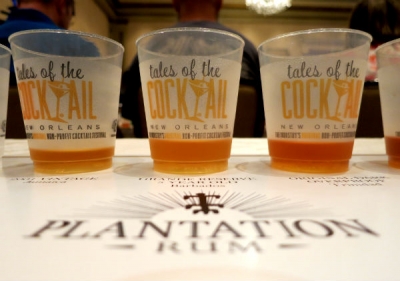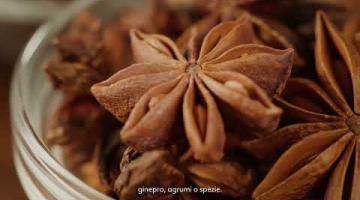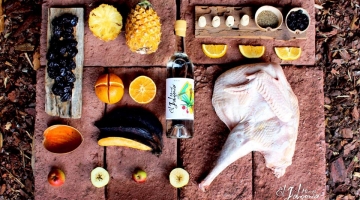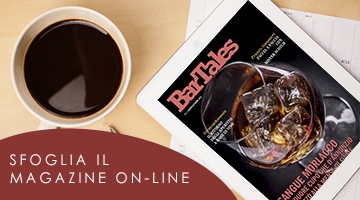Which Rum, What Cocktail and Why?
This seminar was presented by Plantation Rum and held by Jeff Berry, Alexandre Gabriel, Martin Cate and Philip Duff and the room was packed and of course all the usual suspects were there
They took us through the history of rum, the tiki era, Don the Beachcomber, Trader Vic… and then a very interesting theory about the rums Trader Vic used in his Mai Tais, or rather the Martinique rum part. Most of us (if not all ?) have always thought that the Martinique rum Trader Vic used was an agricole rum, but there is a new theory on this that the rum actually was a molasses based rum and not an agricole.
How’s that and why?
Well, there seem to be some things that points to that, for example the Martinique rum was described at the time as a rum with a “heavy coffee color”, here is the points according to Martin Cate including a pic of the jet-black Barum bottled in Jamaica:
1. Very few agricoles were exported to the US at that time. Only brand I can see in the US is Saint James. Don Beach had no agricoles at all on his 1940s rum menu. Don describes Martinique rum as “Heavy-bodied, medium pungency” and “Not as dry as the Cuban nor as rummy as the Jamaican” – no word about grassiness or a different raw material at all.
2. His first Adjusted Mai Tai recipe uses Coruba- lightly aged black Jamaican rum. Heavier bodied, but no depth of character.
3. He described using Trader Vic’s brand Martinique rum in the 1950 to match the desired “nutty” flavor of the older Jamaican.
4. Trader Vic’s 1946 Book of Food and Drink (and 1947 and 172 Bartenders Guide) describe Martinique rum as “Commonly known as French rums, they are usually heavy in body, coffee-colored, very similar to Jamaica rums, but in many cases have the dry burned flavor of the Demerara.”
There’s just no way that’s agricole. Also, Vic cited and used Negrita- a black rum from the French islands that is molasses based.
Vic’s Martinique Rum List: Outstanding brands: Bellows Martinique* Black Head* Rhum St. James Barum* Casa Grazia (?) Gosling’s Martinique* Rhum Charleston* Rhum Chauvet* Rhum Risetta* Rhum Negrita*
*All Traditionelle
Then: Creation of Vic’s Brand Mai Tai Rum – 1960s:
“This rum was made to recapture the characteristics of the original 17-year-old rum. First he skillfully blended Jamaican rums and then added Martinique rum for its elusive and wonderful nutlike flavor (ed – that’s got to be rhum traditionelle) and a bit of light Virgin Island rum for the smoothness of body. (ed. – that’s just padding to keep the cost down) This combination became the Trader Vic Mai Tai rum as we know it today.” (“Today” being the 1960s)
So to me it looks like it’s true that the Martinique rum was actually molasses based. The rum world is really interesting stuff…Sure I wrote a note about this when I reviewed the Denizen Merchant’s Reserve rum which is a blend with both Jamaican rums and molasses based Martinique rum (Grand Arome) but being at this seminar and Martin Cate helped me get more and deeper understanding of the details.
Martin Cate is still of the opinion though, that making a Mai Tai with half Jamaican and half Agricole is delicious regardless! I tend to agree…
Next up, more about rum….yeah I have a hard time staying away from any seminar talking about my favorite cane spirit….
FLORIDITA – The cradle of the Daiquiri
This years Tales did not disappoint, I think it was even better than last year. One of the seminars I went to was “The Floridita: cradle of the Daiquiri” held by Jeff “Beachbum” Berry and David Wondrich and presented by Bacardi Rum. The seminar took us back to the 1930′s Havana and head bartender Constantino Ribalaigua Vert who even taught Trader Vic how to make tropical drinks! (Trader Vic also went to New Orleans to learn how to mix drinks – after all Nola is the birthplace of the cocktail…)
The recipe for the classic daiquiri was 2 oz white rum, juice of 1/2 hand-squeezed lime, 1 tsp sugar and the drink was mostly stirred but sometimes shaken – “thrown Cuban style” that is. The limes used were the large limes most of us are used to, not the smaller key limes and they were squeezed by hand.
Hemingway who moved to Havana and there discovered the Floridita asked his daiquiri to be changed – double the rum, eliminate the sugar (he had diabetes) and adding grapefruit juice and maraschino and the Papa Double was invented, also called the Hemingway daiquiri.
His record of Papa Double consumption was 17 drinks from the morning to the evening – he really loved his daiquiri! But he didn’t drink just daiquiris, he also used to drink for example, a cocktail called “Ideal” while reading his daily paper. The Ideal was 1 oz Italian vermouth, 1 oz French vermouth, 1 oz dry gin, 3/4 oz grapefruit juice and a tsp maraschino.
One of Constantinos trademarks was the combination of grapefruit and maraschino and he used a lot of fresh mint, sugar instead of syrup, dashes of curacao and lime peel – as ingredient. He became known for consistency and a generally high quality on his cocktails.
Constantino also had an “ice program” where different styles of ice were grouped into four: 1 – Menudo (cracked) 2 – Menudito (chpped) 3 – Afeitado (shaved) 4 – Frappe’ (snow) and when the daiquiri was made simple syrup wasn’t used because syrup adds a different texture and taste and instead the sugar was stirred into the juices. So you can see with what great care he took the attention to details in his drink mixing.
And from Hemingway Floridita got fame, fortune and became one of Esquire’s top seven bars in the world at the time.
Now, Trader Vic, who sat at the bar Floridita to study how tropical drinks were mixed took Constantino’s daiquiri recipe with him when he left and put it on his menu and called it “Trader Vic’s Daiquiri’………and his book the 1940′ s Bar Guide was the result of his studying in the Floridita and Constantino’s work.
The seminar taught us about the history of Floridita and the history of the daiquiri but there were more things than that mentioned, among them Don Beach, Trader Vic and of course, the Mai Tai, how can you not hear something about the Mai Tai when Jeff Berry is one of the panelists?
And to wrap it all up – I would recommend anyone to go to the Tales! it’s such an experience, it’s fun, you meet fun and interesting people and you learn a lot!
Next post coming up soon – the tastings!
thanks to original post http://www.amountainofcrushedice.com/?p=19258
















